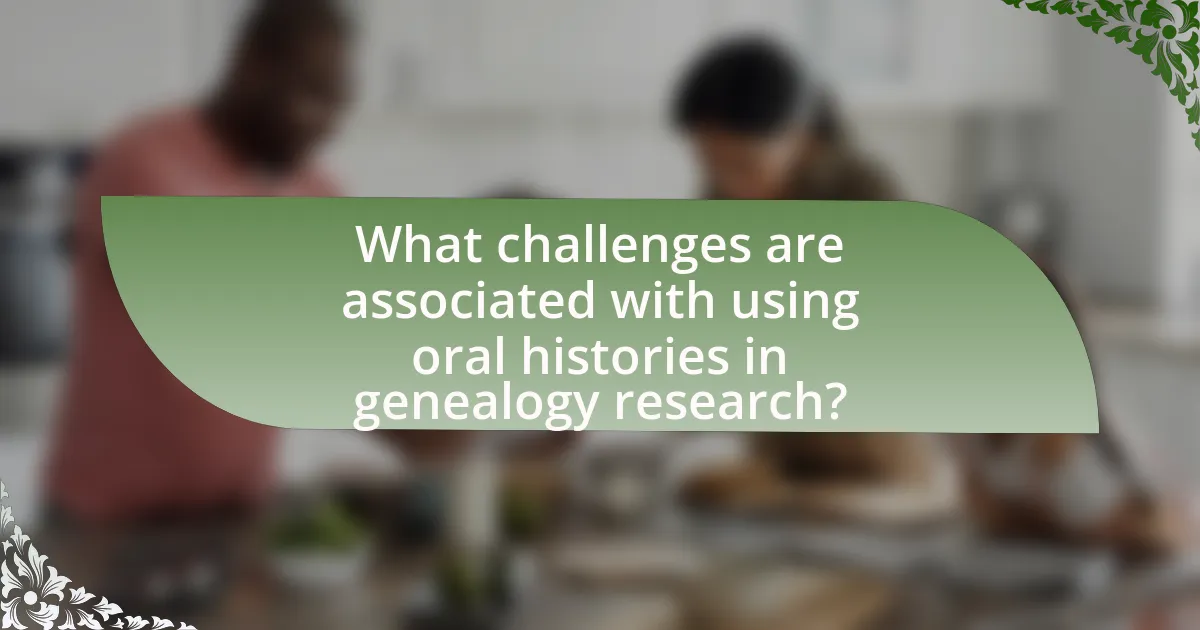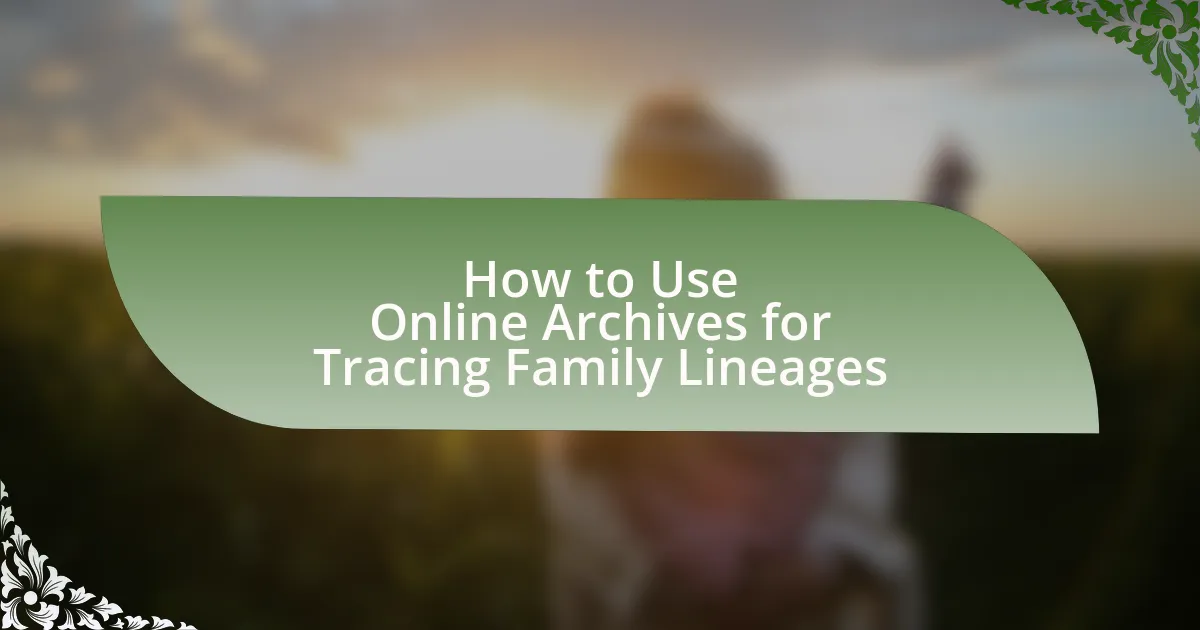Oral histories are essential in genealogy research, providing personal narratives and firsthand accounts that enhance traditional records. They offer insights into family lineage, cultural practices, and historical events, often filling gaps in documentation, particularly for marginalized communities. The article explores the methods of collecting oral histories, the types of information they can reveal, and their role in complementing traditional genealogical records. It also addresses the challenges of accuracy and bias in oral histories, ethical considerations, and best practices for integrating and archiving these narratives in family history projects.
What is the role of oral histories in genealogy research?

Oral histories play a crucial role in genealogy research by providing personal narratives and firsthand accounts that complement traditional records. These narratives often capture details about family members, cultural practices, and historical events that may not be documented in written sources. For instance, oral histories can reveal relationships, migration patterns, and life experiences that enrich the understanding of family lineage. Research indicates that oral histories can fill gaps in historical records, especially for marginalized communities where documentation may be sparse. This qualitative data enhances genealogical research by adding depth and context to family histories, making it a valuable tool for researchers.
How do oral histories contribute to understanding family lineage?
Oral histories significantly contribute to understanding family lineage by preserving personal narratives and cultural contexts that are often absent from written records. These narratives provide insights into familial relationships, migration patterns, and historical events that shape a family’s identity. For instance, oral histories can reveal connections between generations, such as the experiences of ancestors during significant historical moments, which may not be documented elsewhere. This information enriches genealogical research by filling gaps in official records, thereby offering a more comprehensive view of a family’s heritage.
What types of information can be gathered from oral histories?
Oral histories can gather personal narratives, cultural traditions, family lineage, and historical events. These narratives provide insights into individual experiences and community values, often revealing details about ancestors’ lives that are not documented elsewhere. For example, oral histories can include specific anecdotes about migration patterns, occupations, and social relationships, which are crucial for understanding family histories and cultural heritage. Additionally, they can capture the emotional context of historical events, offering a richer perspective on the past that complements written records.
How do oral histories complement traditional genealogical records?
Oral histories complement traditional genealogical records by providing personal narratives and context that are often absent in official documents. While genealogical records such as birth, marriage, and death certificates offer factual data, oral histories capture the lived experiences, cultural practices, and family stories that enrich understanding of ancestry. For example, oral histories can reveal relationships, migration patterns, and social dynamics that are not documented in formal records, thereby filling gaps and adding depth to genealogical research. This combination enhances the overall narrative of a family’s history, making it more comprehensive and relatable.
Why are oral histories important in genealogy research?
Oral histories are important in genealogy research because they provide personal narratives and firsthand accounts that enrich family histories. These narratives often include details about ancestors’ lives, cultural practices, and historical contexts that are not found in official records. For instance, oral histories can reveal family traditions, migration stories, and unique experiences that contribute to a more comprehensive understanding of one’s lineage. Additionally, they can help fill gaps in documentation, especially for individuals from marginalized communities where written records may be scarce.
What unique perspectives do oral histories provide?
Oral histories provide unique perspectives by capturing personal narratives and lived experiences that are often absent from traditional historical records. These narratives offer insights into cultural practices, social dynamics, and individual emotions, enriching the understanding of historical events. For example, oral histories can reveal the impact of migration on families, as seen in the collection of interviews conducted by the Oral History Association, which highlights diverse immigrant experiences that are not documented in official records. This depth of personal context allows researchers to connect with the past in a more nuanced way, making oral histories invaluable in genealogy research.
How can oral histories help fill gaps in genealogical data?
Oral histories can help fill gaps in genealogical data by providing personal narratives and details that are often absent from official records. These narratives can include information about family relationships, migration patterns, and cultural practices that may not be documented elsewhere. For instance, oral histories can reveal the names of ancestors, their occupations, and significant life events, which can be crucial for constructing a more complete family tree. Additionally, oral histories can offer context about historical events that affected families, such as wars or economic changes, thereby enriching genealogical research with lived experiences and perspectives that are not captured in traditional records.
What methods are used to collect oral histories for genealogy?

Methods used to collect oral histories for genealogy include interviews, focus groups, and audio or video recordings. Interviews are typically conducted one-on-one, allowing for in-depth conversations that capture personal narratives and family stories. Focus groups involve gathering multiple individuals to discuss shared experiences, which can reveal collective memories and insights. Audio and video recordings preserve the authenticity of the oral histories, providing a rich resource for future research. These methods are validated by their widespread use in historical and genealogical studies, demonstrating their effectiveness in capturing and preserving personal and familial narratives.
How can researchers effectively conduct oral history interviews?
Researchers can effectively conduct oral history interviews by preparing thoroughly, establishing rapport with interviewees, and using open-ended questions. Preparation involves researching the interviewee’s background and formulating questions that encourage detailed responses. Establishing rapport is crucial as it helps interviewees feel comfortable sharing personal stories, which enhances the richness of the data collected. Open-ended questions allow for expansive answers, providing deeper insights into the interviewee’s experiences. According to the Oral History Association, effective interviews often result from a combination of these strategies, leading to valuable historical narratives that contribute significantly to genealogy research.
What techniques enhance the quality of oral history interviews?
Techniques that enhance the quality of oral history interviews include thorough preparation, active listening, and open-ended questioning. Thorough preparation involves researching the interviewee’s background and formulating relevant questions, which helps to create a comfortable environment and encourages detailed responses. Active listening allows the interviewer to engage with the interviewee’s narrative, prompting further exploration of significant topics. Open-ended questions facilitate richer storytelling, as they encourage interviewees to share their experiences in their own words, leading to more nuanced and informative accounts. These techniques are supported by best practices in oral history methodology, which emphasize the importance of creating a respectful and engaging atmosphere for interviewees.
How should researchers prepare for an oral history interview?
Researchers should prepare for an oral history interview by conducting thorough background research on the interviewee and the historical context of their experiences. This preparation includes developing a list of open-ended questions that encourage detailed responses, ensuring that the questions are relevant to the interviewee’s life and experiences. Additionally, researchers should familiarize themselves with recording equipment and techniques to ensure high-quality audio or video capture, as well as obtaining informed consent from the interviewee regarding the use of the recorded material. This approach enhances the quality and depth of the oral history collected, contributing valuable insights to genealogy research.
What tools and technologies assist in recording oral histories?
Digital audio recorders are essential tools for recording oral histories. These devices capture high-quality audio, ensuring that the narratives are preserved accurately. Additionally, smartphones equipped with recording applications provide a convenient alternative, allowing users to record interviews on-the-go. Video cameras also play a significant role, as they capture both audio and visual elements, enriching the storytelling experience. Furthermore, transcription software aids in converting recorded audio into text, making it easier to analyze and archive oral histories. These technologies collectively enhance the process of documenting personal narratives, contributing to the preservation of cultural heritage and genealogical research.
What are the best practices for audio and video recording?
The best practices for audio and video recording include ensuring high-quality equipment, selecting a quiet environment, and using proper microphone techniques. High-quality equipment, such as professional microphones and cameras, significantly enhances the clarity of recordings, making them more useful for oral histories. A quiet environment minimizes background noise, which can distract from the content being recorded. Proper microphone techniques, such as positioning the microphone close to the speaker and using windshields outdoors, help capture clear audio. These practices are essential for preserving oral histories effectively, as they ensure that the recorded material is both clear and engaging for future listeners.
How can transcription software aid in documenting oral histories?
Transcription software aids in documenting oral histories by converting spoken narratives into written text, which enhances accessibility and preservation. This technology allows researchers to capture detailed accounts of personal experiences, ensuring that valuable historical information is accurately recorded and easily searchable. For instance, studies show that digitized oral histories can be indexed and archived, making them available for future generations and facilitating genealogical research.
What challenges are associated with using oral histories in genealogy research?

Using oral histories in genealogy research presents several challenges, including issues of accuracy, memory reliability, and potential bias. Oral histories often rely on personal recollections, which can be influenced by the passage of time, leading to inaccuracies in details such as dates, names, and events. Research indicates that human memory is fallible; for instance, studies show that memories can be altered or forgotten over time, affecting the reliability of the information provided. Additionally, oral histories may reflect the biases of the narrator, as individuals may emphasize certain aspects of their experiences while omitting others, resulting in a skewed perspective. This subjectivity can complicate the verification of facts against documented evidence, making it difficult for genealogists to establish a comprehensive and accurate family history.
How can researchers address the reliability of oral histories?
Researchers can address the reliability of oral histories by employing a multi-faceted approach that includes cross-referencing accounts, verifying details with historical records, and assessing the context of the narratives. Cross-referencing involves comparing oral accounts with written documents, such as census data or family records, to identify discrepancies or corroborate facts. Verifying details can include checking dates, locations, and events mentioned in the oral histories against established historical timelines. Additionally, assessing the context involves understanding the social, cultural, and emotional factors that may influence a narrator’s memory and perspective, which can help researchers gauge the potential biases or motivations behind the stories shared. This comprehensive method enhances the credibility of oral histories in genealogy research.
What factors can affect the accuracy of oral histories?
The accuracy of oral histories can be affected by several factors, including memory distortion, the influence of social context, and the passage of time. Memory distortion occurs as individuals may unintentionally alter details of their recollections, influenced by subsequent experiences or discussions. The social context, such as the presence of others during the recounting, can lead to conformity or embellishment, impacting the authenticity of the narrative. Additionally, the passage of time can result in fading memories, where specific details become less reliable, leading to inaccuracies in the oral history. These factors collectively contribute to the challenges in verifying the accuracy of oral histories in genealogy research.
How can biases in oral histories be identified and mitigated?
Biases in oral histories can be identified and mitigated through critical analysis and cross-referencing with other sources. Researchers should evaluate the context in which the oral history was recorded, including the interviewee’s background, motivations, and the circumstances surrounding the narrative. For instance, discrepancies between oral accounts and documented historical events can highlight potential biases. Additionally, employing a diverse range of sources, such as written records, photographs, and artifacts, allows for a more balanced understanding of the subject matter. This triangulation of data helps to validate or challenge the oral history, thereby reducing the impact of individual biases.
What ethical considerations should be taken into account?
Ethical considerations in genealogy research involving oral histories include informed consent, privacy, and the potential for emotional harm. Researchers must obtain explicit permission from individuals sharing their stories, ensuring they understand how their information will be used. Privacy is crucial, as sharing sensitive family histories can impact living relatives; thus, researchers should anonymize data when necessary. Additionally, the emotional impact of recounting personal or traumatic experiences must be considered, as it can lead to distress for both the storyteller and the researcher. These considerations are essential to uphold respect and integrity in the research process.
How should consent be obtained from interview subjects?
Consent from interview subjects should be obtained through a clear and informed process. This involves providing subjects with comprehensive information about the purpose of the interview, how their data will be used, and any potential risks involved. Additionally, subjects must be given the opportunity to ask questions and must voluntarily agree to participate without any coercion. This process aligns with ethical research standards, ensuring that participants are fully aware of their rights and the implications of their involvement.
What are the implications of sharing oral histories publicly?
Sharing oral histories publicly can lead to both positive and negative implications. On the positive side, public sharing enhances community engagement and preserves cultural heritage, allowing diverse narratives to be documented and accessed by future generations. For instance, projects like StoryCorps have successfully recorded and shared personal stories, fostering a sense of connection and understanding among different communities. Conversely, sharing oral histories can also raise concerns about privacy and consent, particularly if sensitive information is disclosed without the subjects’ approval. This has been highlighted in discussions around the ethical considerations of oral history projects, where the potential for misrepresentation or exploitation of personal narratives poses significant risks. Thus, while public sharing of oral histories can enrich genealogical research and cultural understanding, it necessitates careful consideration of ethical implications and the protection of individuals’ rights.
What are the best practices for integrating oral histories into genealogy research?
The best practices for integrating oral histories into genealogy research include conducting thorough interviews, documenting the narratives accurately, and cross-referencing the information with existing records. Conducting interviews involves preparing questions in advance and creating a comfortable environment for the interviewee, which enhances the quality of the information gathered. Accurate documentation requires recording the interviews, taking detailed notes, and transcribing the narratives to preserve the original context and nuances. Cross-referencing the oral histories with census records, birth and death certificates, and other genealogical sources ensures the reliability of the information and helps to fill in gaps in the family history. These practices enhance the richness and accuracy of genealogical research, as evidenced by studies showing that oral histories can provide unique insights and details not found in written records.
How can oral histories be effectively documented and archived?
Oral histories can be effectively documented and archived by utilizing audio and video recording technologies, ensuring high-quality capture of narratives. This method allows for the preservation of the speaker’s voice, tone, and emotion, which are critical for conveying the full context of their stories. Additionally, transcribing these recordings into written formats enhances accessibility and searchability, facilitating easier retrieval of specific information.
Archiving should involve storing these recordings and transcripts in both physical and digital formats, using reliable storage solutions that protect against data loss. For instance, organizations like the Library of Congress recommend using multiple backup systems, including cloud storage and external hard drives, to safeguard oral histories. Furthermore, metadata should be created for each recording, detailing the interviewee’s background, the date of the interview, and the context of the stories shared, which aids in future research and retrieval.
Implementing these practices ensures that oral histories are preserved for future generations, contributing significantly to genealogy research and cultural heritage documentation.
What strategies can enhance the use of oral histories in family history projects?
To enhance the use of oral histories in family history projects, researchers should employ strategies such as structured interviews, community engagement, and digital archiving. Structured interviews ensure that key topics are covered consistently, allowing for comprehensive data collection. Engaging with the community fosters trust and encourages participation, which can lead to richer narratives. Digital archiving facilitates easy access and preservation of oral histories, making them available for future generations. These strategies are supported by studies indicating that structured methodologies improve the quality of oral history data and that community involvement increases the diversity of perspectives captured.




